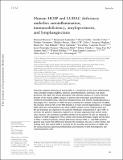Human HOIP and LUBAC deficiency underlies autoinflammation, immunodeficiency, amylopectinosis, and lymphangiectasia

View/
Author
Boisson, Bertrand
Laplantine, Emmanuel
Dobbs, Kerry
Cobat, Aurélie
Tarantino, Nadine
Du, Likun
Belkadi, Aziz
Chrabieh, Maya
Itan, Yuval
Picard, Capucine
Fournet, Jean-Christophe
Eibel, Hermann
Tsitsikov, Erdyni
Abel, Laurent
Al-Herz, Waleed
Casanova, Jean-Laurent
Israel, Alain
Note: Order does not necessarily reflect citation order of authors.
Published Version
https://doi.org/10.1084/jem.20141130Metadata
Show full item recordCitation
Boisson, B., E. Laplantine, K. Dobbs, A. Cobat, N. Tarantino, M. Hazen, H. G. Lidov, et al. 2015. “Human HOIP and LUBAC deficiency underlies autoinflammation, immunodeficiency, amylopectinosis, and lymphangiectasia.” The Journal of Experimental Medicine 212 (6): 939-951. doi:10.1084/jem.20141130. http://dx.doi.org/10.1084/jem.20141130.Abstract
Inherited, complete deficiency of human HOIL-1, a component of the linear ubiquitination chain assembly complex (LUBAC), underlies autoinflammation, infections, and amylopectinosis. We report the clinical description and molecular analysis of a novel inherited disorder of the human LUBAC complex. A patient with multiorgan autoinflammation, combined immunodeficiency, subclinical amylopectinosis, and systemic lymphangiectasia, is homozygous for a mutation in HOIP, the gene encoding the catalytic component of LUBAC. The missense allele (L72P, in the PUB domain) is at least severely hypomorphic, as it impairs HOIP expression and destabilizes the whole LUBAC complex. Linear ubiquitination and NF-κB activation are impaired in the patient’s fibroblasts stimulated by IL-1β or TNF. In contrast, the patient’s monocytes respond to IL-1β more vigorously than control monocytes. However, the activation and differentiation of the patient’s B cells are impaired in response to CD40 engagement. These cellular and clinical phenotypes largely overlap those of HOIL-1-deficient patients. Clinical differences between HOIL-1- and HOIP-mutated patients may result from differences between the mutations, the loci, or other factors. Our findings show that human HOIP is essential for the assembly and function of LUBAC and for various processes governing inflammation and immunity in both hematopoietic and nonhematopoietic cells.Other Sources
http://www.ncbi.nlm.nih.gov/pmc/articles/PMC4451137/pdf/Terms of Use
This article is made available under the terms and conditions applicable to Other Posted Material, as set forth at http://nrs.harvard.edu/urn-3:HUL.InstRepos:dash.current.terms-of-use#LAACitable link to this page
http://nrs.harvard.edu/urn-3:HUL.InstRepos:23993608
Collections
- HMS Scholarly Articles [17922]
Contact administrator regarding this item (to report mistakes or request changes)


